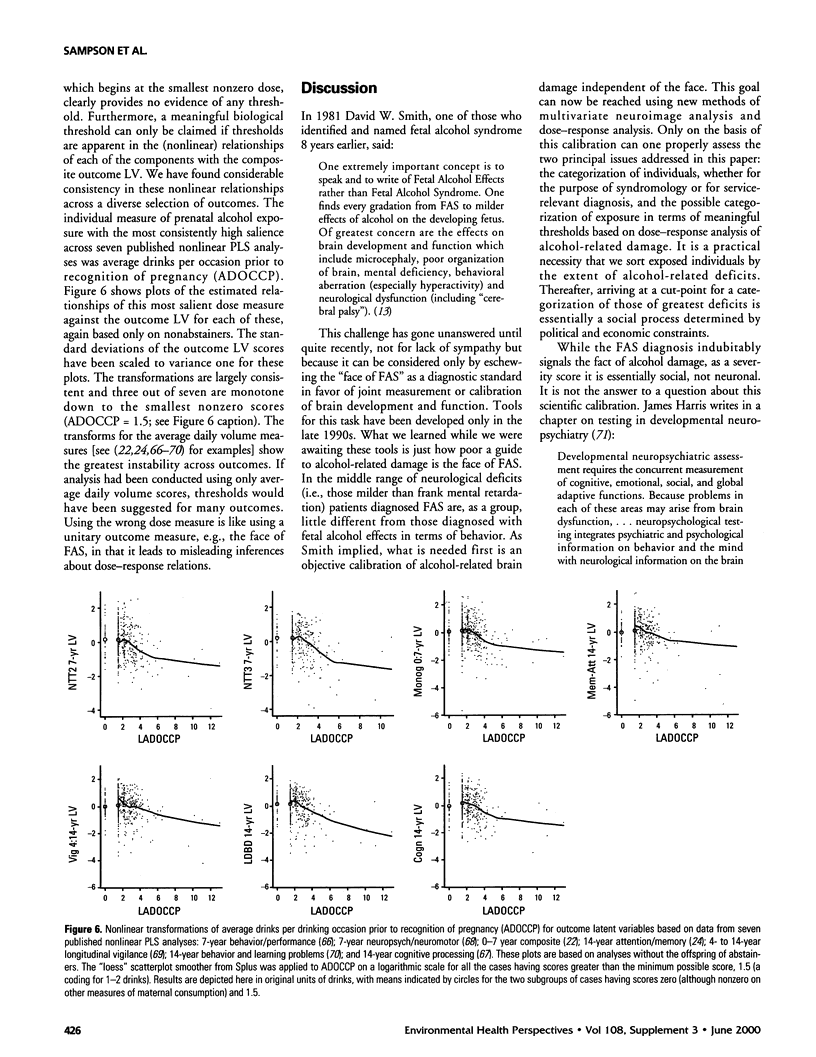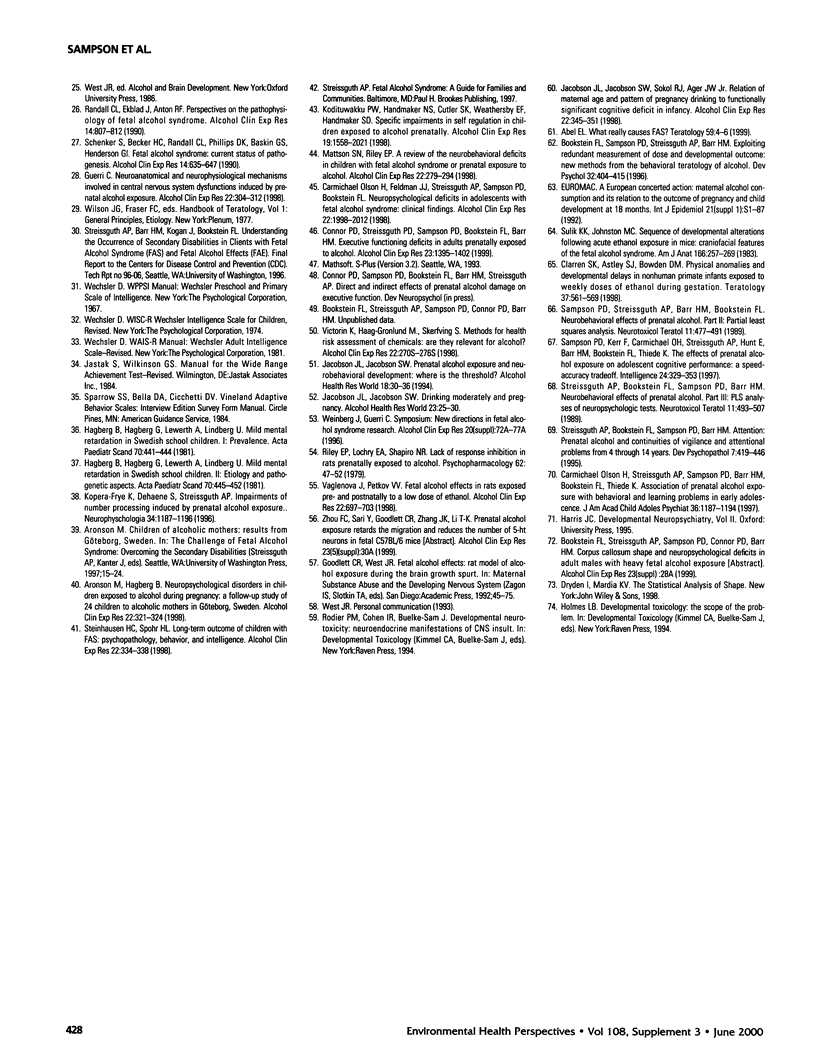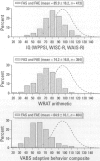Abstract
In biomedical scientific investigations, expositions of findings are conceptually simplest when they comprise comparisons of discrete groups of individuals or involve discrete features or characteristics of individuals. But the descriptive benefits of categorization become outweighed by their limitations in studies involving dose-response relationships, as in many teratogenic and environmental exposure studies. This article addresses a pair of categorization issues concerning the effects of prenatal alcohol exposure that have important public health consequences: the labeling of individuals as fetal alcohol syndrome (FAS) versus fetal alcohol effects (FAE) or alcohol-related neurodevelopmental disorder (ARND), and the categorization of prenatal exposure dose by thresholds. We present data showing that patients with FAS and others with FAE do not have meaningfully different behavioral performance, standardized scores of IQ, arithmetic and adaptive behavior, or secondary disabilities. Similarly overlapping distributions on measures of executive functioning offer a basis for identifying alcohol-affected individuals in a manner that does not simply reflect IQ deficits. At the other end of the teratological continuum, we turn to the reporting of threshold effects in dose-response relationships. Here we illustrate the importance of multivariate analyses using data from the Seattle, Washington, longitudinal prospective study on alcohol and pregnancy. Relationships between many neurobehavioral outcomes and measures of prenatal alcohol exposure are monotone without threshold down to the lowest nonzero levels of exposure, a finding consistent with reports from animal studies. In sum, alcohol effects on the developing human brain appear to be a continuum without threshold when dose and behavioral effects are quantified appropriately.
Full text
PDF







Images in this article
Selected References
These references are in PubMed. This may not be the complete list of references from this article.
- Abel E. L. What really causes FAS? Teratology. 1999 Jan;59(1):4–6. doi: 10.1002/(SICI)1096-9926(199901)59:1<4::AID-TERA3>3.0.CO;2-C. [DOI] [PubMed] [Google Scholar]
- Aronson M., Hagberg B. Neuropsychological disorders in children exposed to alcohol during pregnancy: a follow-up study of 24 children to alcoholic mothers in Göteborg, Sweden. Alcohol Clin Exp Res. 1998 Apr;22(2):321–324. doi: 10.1111/j.1530-0277.1998.tb03655.x. [DOI] [PubMed] [Google Scholar]
- Clarren S. K., Astley S. J., Bowden D. M. Physical anomalies and developmental delays in nonhuman primate infants exposed to weekly doses of ethanol during gestation. Teratology. 1988 Jun;37(6):561–569. doi: 10.1002/tera.1420370605. [DOI] [PubMed] [Google Scholar]
- Clarren S. K., Smith D. W. The fetal alcohol syndrome. N Engl J Med. 1978 May 11;298(19):1063–1067. doi: 10.1056/NEJM197805112981906. [DOI] [PubMed] [Google Scholar]
- Connor P. D., Streissguth A. P., Sampson P. D., Bookstein F. L., Barr H. M. Individual differences in auditory and visual attention among fetal alcohol-affected adults. Alcohol Clin Exp Res. 1999 Aug;23(8):1395–1402. [PubMed] [Google Scholar]
- Goldschmidt L., Richardson G. A., Stoffer D. S., Geva D., Day N. L. Prenatal alcohol exposure and academic achievement at age six: a nonlinear fit. Alcohol Clin Exp Res. 1996 Jun;20(4):763–770. doi: 10.1111/j.1530-0277.1996.tb01684.x. [DOI] [PubMed] [Google Scholar]
- Guerri C. Neuroanatomical and neurophysiological mechanisms involved in central nervous system dysfunctions induced by prenatal alcohol exposure. Alcohol Clin Exp Res. 1998 Apr;22(2):304–312. doi: 10.1111/j.1530-0277.1998.tb03653.x. [DOI] [PubMed] [Google Scholar]
- Habbick B. F., Blakley P. M., Houston C. S., Snyder R. E., Senthilselvan A., Nanson J. L. Bone age and growth in fetal alcohol syndrome. Alcohol Clin Exp Res. 1998 Sep;22(6):1312–1316. [PubMed] [Google Scholar]
- Hagberg B., Hagberg G., Lewerth A., Lindberg U. Mild mental retardation in Swedish school children. I. Prevalence. Acta Paediatr Scand. 1981 Jul;70(4):441–444. doi: 10.1111/j.1651-2227.1981.tb05720.x. [DOI] [PubMed] [Google Scholar]
- Hagberg B., Hagberg G., Lewerth A., Lindberg U. Mild mental retardation in Swedish school children. II. Etiologic and pathogenetic aspects. Acta Paediatr Scand. 1981 Jul;70(4):445–452. doi: 10.1111/j.1651-2227.1981.tb05721.x. [DOI] [PubMed] [Google Scholar]
- Hanson J. W., Streissguth A. P., Smith D. W. The effects of moderate alcohol consumption during pregnancy on fetal growth and morphogenesis. J Pediatr. 1978 Mar;92(3):457–460. doi: 10.1016/s0022-3476(78)80449-1. [DOI] [PubMed] [Google Scholar]
- Jacobson J. L., Jacobson S. W. Drinking moderately and pregnancy. Effects on child development. Alcohol Res Health. 1999;23(1):25–30. [PMC free article] [PubMed] [Google Scholar]
- Jacobson J. L., Jacobson S. W., Sokol R. J., Ager J. W., Jr Relation of maternal age and pattern of pregnancy drinking to functionally significant cognitive deficit in infancy. Alcohol Clin Exp Res. 1998 Apr;22(2):345–351. doi: 10.1111/j.1530-0277.1998.tb03659.x. [DOI] [PubMed] [Google Scholar]
- Jacobson J. L., Jacobson S. W., Sokol R. J., Martier S. S., Ager J. W., Kaplan-Estrin M. G. Teratogenic effects of alcohol on infant development. Alcohol Clin Exp Res. 1993 Feb;17(1):174–183. doi: 10.1111/j.1530-0277.1993.tb00744.x. [DOI] [PubMed] [Google Scholar]
- Jacobson S. W., Jacobson J. L., Sokol R. J. Effects of fetal alcohol exposure on infant reaction time. Alcohol Clin Exp Res. 1994 Oct;18(5):1125–1132. doi: 10.1111/j.1530-0277.1994.tb00092.x. [DOI] [PubMed] [Google Scholar]
- Jacobson S. W., Jacobson J. L., Sokol R. J., Martier S. S., Ager J. W. Prenatal alcohol exposure and infant information processing ability. Child Dev. 1993 Dec;64(6):1706–1721. [PubMed] [Google Scholar]
- Jones K. L., Smith D. W. Recognition of the fetal alcohol syndrome in early infancy. Lancet. 1973 Nov 3;302(7836):999–1001. doi: 10.1016/s0140-6736(73)91092-1. [DOI] [PubMed] [Google Scholar]
- Kodituwakku P. W., Handmaker N. S., Cutler S. K., Weathersby E. K., Handmaker S. D. Specific impairments in self-regulation in children exposed to alcohol prenatally. Alcohol Clin Exp Res. 1995 Dec;19(6):1558–1564. doi: 10.1111/j.1530-0277.1995.tb01024.x. [DOI] [PubMed] [Google Scholar]
- Kopera-Frye K., Dehaene S., Streissguth A. P. Impairments of number processing induced by prenatal alcohol exposure. Neuropsychologia. 1996 Dec;34(12):1187–1196. doi: 10.1016/0028-3932(96)00043-7. [DOI] [PubMed] [Google Scholar]
- Löser H., Bierstedt T., Blum A. Alkoholembryopathie im Erwachsenenalter. Eine Langzeituntersuchung. Dtsch Med Wochenschr. 1999 Apr 9;124(14):412–418. doi: 10.1055/s-2007-1024327. [DOI] [PubMed] [Google Scholar]
- Majewski F., Bierich J. R., Löser H., Michaelis R., Leiber B., Bettecken F. Zur Klinik und Pathogenese der Alkohol-Embryopathie. Bericht über 68 Fälle. MMW Munch Med Wochenschr. 1976 Dec 10;118(50):1635–1642. [PubMed] [Google Scholar]
- Mattson S. N., Riley E. P. A review of the neurobehavioral deficits in children with fetal alcohol syndrome or prenatal exposure to alcohol. Alcohol Clin Exp Res. 1998 Apr;22(2):279–294. doi: 10.1111/j.1530-0277.1998.tb03651.x. [DOI] [PubMed] [Google Scholar]
- Olson H. C., Feldman J. J., Streissguth A. P., Sampson P. D., Bookstein F. L. Neuropsychological deficits in adolescents with fetal alcohol syndrome: clinical findings. Alcohol Clin Exp Res. 1998 Dec;22(9):1998–2012. [PubMed] [Google Scholar]
- Olson H. C., Streissguth A. P., Sampson P. D., Barr H. M., Bookstein F. L., Thiede K. Association of prenatal alcohol exposure with behavioral and learning problems in early adolescence. J Am Acad Child Adolesc Psychiatry. 1997 Sep;36(9):1187–1194. doi: 10.1097/00004583-199709000-00010. [DOI] [PubMed] [Google Scholar]
- Randall C. L., Ekblad U., Anton R. F. Perspectives on the pathophysiology of fetal alcohol syndrome. Alcohol Clin Exp Res. 1990 Dec;14(6):807–812. doi: 10.1111/j.1530-0277.1990.tb01818.x. [DOI] [PubMed] [Google Scholar]
- Riley E. P., Lochry E. A., Shapiro N. R. Lack of response inhibition in rats prenatally exposed to alcohol. Psychopharmacology (Berl) 1979 Mar 29;62(1):47–52. doi: 10.1007/BF00426034. [DOI] [PubMed] [Google Scholar]
- Sampson P. D., Streissguth A. P., Barr H. M., Bookstein F. L. Neurobehavioral effects of prenatal alcohol: Part II. Partial least squares analysis. Neurotoxicol Teratol. 1989 Sep-Oct;11(5):477–491. doi: 10.1016/0892-0362(89)90025-1. [DOI] [PubMed] [Google Scholar]
- Sampson P. D., Streissguth A. P., Bookstein F. L., Little R. E., Clarren S. K., Dehaene P., Hanson J. W., Graham J. M., Jr Incidence of fetal alcohol syndrome and prevalence of alcohol-related neurodevelopmental disorder. Teratology. 1997 Nov;56(5):317–326. doi: 10.1002/(SICI)1096-9926(199711)56:5<317::AID-TERA5>3.0.CO;2-U. [DOI] [PubMed] [Google Scholar]
- Schenker S., Becker H. C., Randall C. L., Phillips D. K., Baskin G. S., Henderson G. I. Fetal alcohol syndrome: current status of pathogenesis. Alcohol Clin Exp Res. 1990 Oct;14(5):635–647. doi: 10.1111/j.1530-0277.1990.tb01220.x. [DOI] [PubMed] [Google Scholar]
- Smith D. W. Fetal alcohol syndrome and fetal alcohol effects. Neurobehav Toxicol Teratol. 1981 Summer;3(2):127–127. [PubMed] [Google Scholar]
- Spohr H. L., Steinhausen H. C. Clinical, psychopathological and developmental aspects in children with the fetal alcohol syndrome: a four-year follow-up study. Ciba Found Symp. 1984;105:197–217. doi: 10.1002/9780470720868.ch12. [DOI] [PubMed] [Google Scholar]
- Spohr H. L., Willms J., Steinhausen H. C. The fetal alcohol syndrome in adolescence. Acta Paediatr Suppl. 1994 Nov;404:19–26. doi: 10.1111/j.1651-2227.1994.tb13379.x. [DOI] [PubMed] [Google Scholar]
- Steinhausen H. C., Spohr H. L. Long-term outcome of children with fetal alcohol syndrome: psychopathology, behavior, and intelligence. Alcohol Clin Exp Res. 1998 Apr;22(2):334–338. doi: 10.1111/j.1530-0277.1998.tb03657.x. [DOI] [PubMed] [Google Scholar]
- Streissguth A. P., Aase J. M., Clarren S. K., Randels S. P., LaDue R. A., Smith D. F. Fetal alcohol syndrome in adolescents and adults. JAMA. 1991 Apr 17;265(15):1961–1967. [PubMed] [Google Scholar]
- Streissguth A. P., Barr H. M., Olson H. C., Sampson P. D., Bookstein F. L., Burgess D. M. Drinking during pregnancy decreases word attack and arithmetic scores on standardized tests: adolescent data from a population-based prospective study. Alcohol Clin Exp Res. 1994 Apr;18(2):248–254. doi: 10.1111/j.1530-0277.1994.tb00009.x. [DOI] [PubMed] [Google Scholar]
- Streissguth A. P., Bookstein F. L., Sampson P. D., Barr H. M. Neurobehavioral effects of prenatal alcohol: Part III. PLS analyses of neuropsychologic tests. Neurotoxicol Teratol. 1989 Sep-Oct;11(5):493–507. doi: 10.1016/0892-0362(89)90026-3. [DOI] [PubMed] [Google Scholar]
- Streissguth A. P., Clarren S. K., Jones K. L. Natural history of the fetal alcohol syndrome: a 10-year follow-up of eleven patients. Lancet. 1985 Jul 13;2(8446):85–91. doi: 10.1016/s0140-6736(85)90189-8. [DOI] [PubMed] [Google Scholar]
- Streissguth A. P., Sampson P. D., Olson H. C., Bookstein F. L., Barr H. M., Scott M., Feldman J., Mirsky A. F. Maternal drinking during pregnancy: attention and short-term memory in 14-year-old offspring--a longitudinal prospective study. Alcohol Clin Exp Res. 1994 Feb;18(1):202–218. doi: 10.1111/j.1530-0277.1994.tb00904.x. [DOI] [PubMed] [Google Scholar]
- Sulik K. K., Johnston M. C. Sequence of developmental alterations following acute ethanol exposure in mice: craniofacial features of the fetal alcohol syndrome. Am J Anat. 1983 Mar;166(3):257–269. doi: 10.1002/aja.1001660303. [DOI] [PubMed] [Google Scholar]
- Vaglenova J., Petkov V. V. Fetal alcohol effects in rats exposed pre- and postnatally to a low dose of ethanol. Alcohol Clin Exp Res. 1998 May;22(3):697–703. [PubMed] [Google Scholar]
- Victorin K., Haag-Grönlund M., Skerfving S. Methods for health risk assessment of chemicals: are they relevant for alcohol? Alcohol Clin Exp Res. 1998 Oct;22(7 Suppl):270S–276S. doi: 10.1097/00000374-199807001-00001. [DOI] [PubMed] [Google Scholar]
- Weinberg J. New directions in fetal alcohol syndrome research. Alcohol Clin Exp Res. 1996 Nov;20(8 Suppl):72A–77A. doi: 10.1111/j.1530-0277.1996.tb01750.x. [DOI] [PubMed] [Google Scholar]




